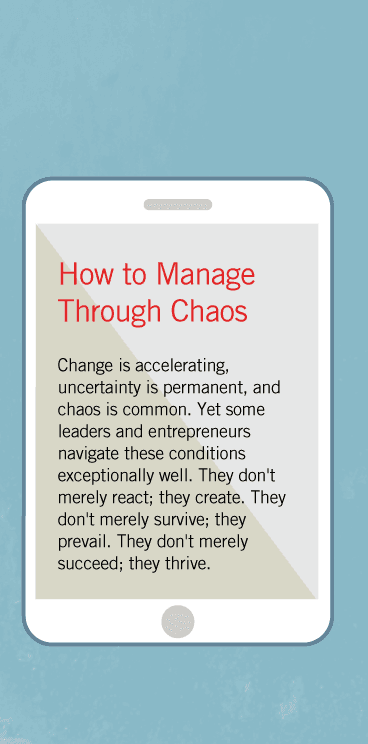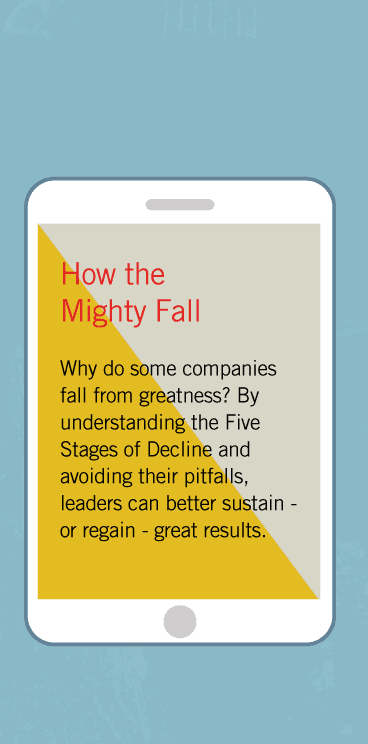| New Publication Turning the Flywheel Jim's latest monograph, in which he shares new and practical insights into one of his most impactful ideas. |
The Flywheel Effect
Pushing with great effort, you get the flywheel to inch forward, moving almost imperceptibly at first. You keep pushing and, after two or three hours of persistent effort, you get the flywheel to complete one entire turn.
You keep pushing, and the flywheel begins to move a bit faster, and with continued great effort, you move it around a second rotation. You keep pushing in a consistent direction. Three turns ... four ... five ... six ... the flywheel builds up speed ... seven ... eight ... you keep pushing ... nine ... ten ... it builds momentum ... eleven ... twelve ... moving faster with each turn … twenty … thirty … fifty … a hundred.
Then, at some point—breakthrough! The momentum of the thing kicks in your favor, hurling the flywheel forward, turn after turn ... whoosh! ... its own heavy weight working for you. You're pushing no harder than during the first rotation, but the flywheel goes faster and faster. Each turn of the flywheel builds upon work done earlier, compounding your investment of effort. A thousand times faster, then ten thousand, then a hundred thousand. The huge heavy disk flies forward, with almost unstoppable momentum.
Now suppose someone came along and asked, "What was the one big push that caused this thing to go so fast?"
You wouldn't be able to answer; it’s just a nonsensical question. Was it the first push? The second? The fifth? The hundredth? No! It was all of them added together in an overall accumulation of effort applied in a consistent direction. Some pushes may have been bigger than others, but any single heave—no matter how large—reflects a small fraction of the entire cumulative effect upon the flywheel.
The flywheel image captures the overall feel of what it was like inside the companies as they went from good to great. No matter how dramatic the end result, the good-to-great transformations never happened in one fell swoop. There was no single defining action, no grand program, no one killer innovation, no solitary lucky break, no wrenching revolution. Good to great comes about by a cumulative process—step by step, action by action, decision by decision, turn by turn of the flywheel—that adds up to sustained and spectacular results.
***
The good-to-great companies understood a simple truth: tremendous power exists in the fact of continued improvement and the delivery of results. Point to tangible accomplishments—however incremental at first—and show how these steps fit into the context of an overall concept that will work. When you do this in such a way that people see and feel the buildup of momentum, they will line up with enthusiasm. We came to call this the flywheel effect, and it applies not only to outside investors but also to internal constituent groups.
Let me share a story from the research. At a pivotal point in the study, members of the research team nearly revolted. Throwing their interview notes on the table, they asked, “Do we have to keep asking that stupid question?”
“What stupid question?” I asked.
“The one about commitment, alignment, and how they managed change.”
“That’s not a stupid question,” I replied. “It’s one of the most important.”
“Well,” said one team member, “a lot of the executives who made the transition—well, they think it’s a stupid question. Some don’t even understand the question!”
“Yes, we need to keep asking it,” I said. “We need to be consistent across the interviews. And, besides, it’s even more interesting that they don’t understand the question. So, keep probing. We’ve got to understand how they overcame resistance to change and got people lined up.”
I fully expected to find that getting everyone lined up— “creating alignment,” to use the jargon—would be one of the top challenges faced by executives working to turn good into great. After all, nearly every executive who’d visited the laboratory had asked this question in one form or another. “How do we get the boat turned?” “How do we get people committed to the new vision?” “How do we motivate people to line up?” “How do we get people to embrace change?”
To my great surprise, we did not find the question of alignment to be a key challenge faced by the good-to-great leaders.
Clearly, the good-to-great companies did get incredible commitment and alignment—they artfully managed change—but they never really spent much time thinking about it. It was utterly transparent to them. We learned that under the right conditions, the problems of commitment, alignment, motivation, and change just melt away. They largely take care of themselves.






